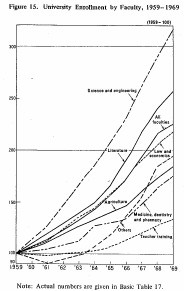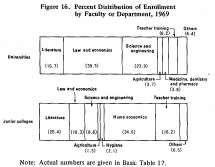| Home > Policy > White Paper, Notice, Announcement > White Paper > EDUCATIONAL STANDARDS IN JAPAN 1971 > CHAPTER |
||
Enrollment has shown a comparatively high rate of increase in the faculties of science, engineering and arts. While total enrollment increased 2.3 times from1959 to 1969, enrollment in science and engineering increased 3.2 times and enrollment in arts 2.6 times.
In terms of percent distribution of university enrollment by faculty, in 1969the faculties of law and economics enrolled the largest proportion of students, followed by those of science and engineering, literature teacher training, medicine, dentistry, and pharmacy, and agriculture in descending order. On the other hand, in junior colleges, the largest percent of students was enrolled in departments of home economics, followed by departments of arts, teacher training, law and economics, science and engineering, hygiene, and agriculture.

Note: Actual numbers are given in Basic Table 17 Basic Table 17
The percent distribution by university faculty is different between national and local public universities on the one hand and private universities on the other. In the national and local public universities in 1969, the percent of science and engineering students was the highest, followed by teacher training, law and economics, and arts. On the other hand, in the private universities, students in arts, and law and economics account for 66%, while science and engineering students make up 22%. In terms of sheer numbers, however, private universities accommodate more science and engineering students than national and local public universities. The number of science and engineering students in private universities was 2 13,000 as against 97,000 in national and local public universities.
Thus, students in humanities and social sciences account for a larger percentage than students in natural sciences in this country. However, in light of the increasing social demand due to developments in science and technology, not only national and local public universities but also private universities are making efforts to expand their science and engineering sectors. These efforts are reflected in the increasing percent of science and engineering students in both national and local public universities, and private universities.

Note: Actual numbers are given in Basic Table 17. Basic Table 17

| Back to Top | MEXT HOME |